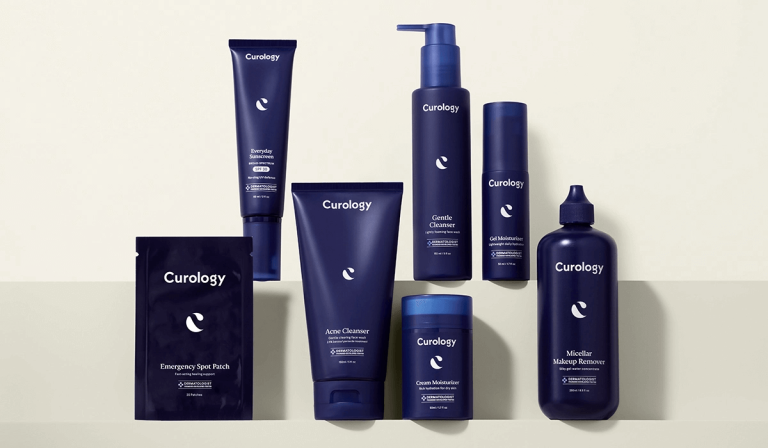How it works:
Share your skin goals and snap selfies
Your dermatology provider prescribes your formula
Apply nightly for happy, healthy skin
How it works:
How it works:
Share your skin goals and snap selfies
Your dermatology provider prescribes your formula
Apply nightly for happy, healthy skin
How it works:
How to prevent stretch marks from forming on your skin
Everything you need to know about why they happen, and how you can minimize their appearance.



Stretch marks (scientific term, striae) are one of the most common forms of skin discoloration that people may experience, occurring in an estimated 50-90% of pregnant women,¹ especially in younger mothers.² But pregnant people aren’t the only individuals who can develop stretch marks. Striae can appear in both men and women, pregnant or not, any time the skin rapidly stretches (or shrinks) for any reason.³
The good news is that they’re not harmful, and they won’t cause complications down the road. They usually fade and become less noticeable on their own over time, so treatment isn’t always necessary, though some may feel more comfortable lessening the appearance of their stretch marks.
If you want to know what exactly stretch marks are, and what (if anything) you can do to keep them from forming, we’re here to help. Here’s a quick rundown on how to prevent stretch marks and some treatment options available to those who might be experiencing distress from these discolorations.
How are stretch marks formed?
The skin has a certain amount of leeway for stretching and shrinking without damage; we call this characteristic, “elasticity.” The two main structures within the skin that control elasticity are collagen⁴ and elastin.⁵ Collagen and elastin are similar–they are fibrous proteins and are the main components of elastic fibers in the skin and other connective tissues. Elastin provides stretch, recoil, and elasticity to the skin,⁶ whereas collagen provides structural support to connective tissues.⁷
When our skin expands or shrinks, those fibers and tissues stretch or shrink along with it. If it expands or shrinks too rapidly, those fibers can sometimes break down and tear, causing the sunken reddish or purplish discolorations that we call stretch marks. They aren’t generally painful, although they can sometimes feel itchy when they first form.
Both men and women can develop stretch marks for a variety of reasons, but there are some factors that might make your skin more susceptible to them.
Pregnancy: This is probably the most well-known cause of stretch marks, and for good reason; as a baby grows in the womb, the mother’s skin stretches to make room.⁸
Gender: Even without the pregnancy factor, stretch marks are more common in females than males.
Ethnicity: Stretch marks may appear more prominent in darker-skinned people.
Hormones: Aside from the hormonal fluctuations common during pregnancy, evidence suggests that differences in hormone receptors in the skin may play a role in the formation of stretch marks.⁹
Genetics: Your DNA plays a big role in all of the skin’s natural processes, including collagen and elastin production; certain genetic disorders (such as Cushing’s syndrome and Marfan syndrome) can make your skin more susceptible as well.¹⁰
Rapid muscle or skeletal growth: Just about everyone goes through major growth spurts during childhood, especially during puberty or adolescence, and sometimes the skin just can’t keep up.¹¹
Rapid weight gain or weight loss: Another well-known cause of scratch marks is rapid weight gain, but few people realize that rapid weight loss can also cause them. Any drastic change in shape of the skin can strain and cause tears and structural changes in the collagen and elastin in the epidermis.¹²
Stress: While we can’t say that stress is a direct cause of stretch marks, evidence suggests that elevated levels of cortisol (our body’s “stress hormone”) weaken the skin’s elasticity by negatively affecting our ability to produce collagen and elastin,¹³ which can make us more susceptible to stretch marks.
How to prevent stretch marks from forming
You might have heard about different tactics to avoid stretch marks, but considering all the different possible causes and factors, there’s really no guaranteed way to prevent them from forming. However, there are ways that we can potentially reduce the risk, especially if we know what to expect.¹⁴
Weight control: Though some fluctuation in weight is often out of our control, avoiding rapid weight gain in pregnancy through a controlled diet and exercise may help the skin to adjust naturally to the stretch of carrying a baby. Additionally, the development of stretch marks seems to be more likely with a higher birth weight of the baby.¹⁵ Still, the health of the baby is paramount, so we don’t want you to limit yourself too much just to save your skin’s appearance.

Moisturizing: Some studies have shown that using a moisturizing cream or oil during pregnancy may help prevent the development of stretch marks, but others have shown that it isn’t very helpful especially from the second trimester on when the baby really starts to grow.¹⁶ We say it can’t hurt, but there’s still no guarantee.
Hydration: Drinking enough water every day can help keep your skin soft and elastic, however, it is unclear if this helps to protect against stretch marks.¹⁷ It also helps to reduce signs of dryness and aging, so bonus points there.
Collagen supplements: Though further research is needed to determine if there is any clinical use of collagen supplements, current studies have shown a link between supplements and increased skin hydration and elasticity.¹⁸
Diets rich in omega fatty acids: These lipids are vital to skin health and resiliency, including our ability to naturally produce our own collagen and elastin, but unfortunately, our bodies don’t produce these essential fatty acids on their own.¹⁹ ²⁰ Diets high in omega-3 and other fatty acids may help prevent stretch marks from forming.
Exercise: Research shows that exercise may improve skin structure,²¹ making it beneficial for limiting early signs of aging. That doesn’t mean it will prevent stretch marks, but at the very least it can’t hurt.
Available treatment options for stretch marks
Sometimes people might brush off the appearance of stretch marks as strictly “cosmetic” and “superficial” concerns, but that doesn’t take away the emotional burden that some people may feel when dealing with them. The good news is that stretch marks will usually fade and become less noticeable on their own over time,²² so don’t feel as though you “need” to do anything to treat them!
But for those folks who may feel bothered by their stretch marks, here are some treatment options:
Over-the-counter or home remedies
Oils and butters: While many turn to oils and butters to reduce the appearance of their stretch marks, most studies show that cocoa butter, shea butter, almond oil, coconut oil, and others don’t have a significant impact on stretch marks, especially once they’ve already developed.²³
Aloe vera gel: This common sunburn treatment may also increase collagen production, which in turn can help to lessen the appearance of stretch marks.²⁴
Retinol: Some studies have shown that retinol and other retinoids may help fade early stretch marks.²⁵

Prescription treatments
Hyaluronic acid: This nutricosmetic has been shown to improve skin hydration as well as stimulate collagen and elastic production in tissue regeneration.²⁶
Tretinoin: Topical tretinoin has been shown to significantly improve early and active stretch marks. However, it’s important to note that tretinoin, a vitamin A derivative, is not considered safe during pregnancy.²⁷
Medical procedures
Medical procedures generally won’t get rid of stretch marks completely, but they can be more effective than other methods in helping them fade faster and become less noticeable.
Microdermabrasion: This is a non-surgical skin resurfacing method where the very top layer of skin is removed and then heals, which has been shown to stimulate collagen production.²⁸
Microneedling: Similar to microdermabrasion, this process uses small needles to produce a controlled injury, which stimulates collagen and elastin production; often used in conjunction with radiofrequency therapy.²⁹
Radiofrequency: This is a minimally invasive procedure using an electric current to stimulate collagen production and skin rejuvenation.³⁰
Fractional laser therapy: A noninvasive procedure that has shown benefit in treating stretch marks as well as sun damage, photoaging, and acne scarring. This procedure uses a laser (light) beam fractured into thousands of microscopic beams.³¹

Taking care of your skin through big life changes
Stretch marks occur naturally, and they can affect anyone, not just pregnant people. They can sometimes be unavoidable, but there are various preventative measures you can take that may help increase your skin’s elasticity and resiliency. If you see stretch marks forming on your skin, know that they will fade naturally over time. When considering any treatment option, it’s always best to talk to your doctor or healthcare provider about your unique situation.
Get your personalized skincare routine with Curology
Get your personalized skincare routine with Curology


If you want to take the guesswork out of your skincare, Curology’s here to help. Our team of licensed dermatology providers is ready to answer any questions you may have and help create a skincare solution tailored to your individual needs. Sign up for a 30-day trial* at Curology today for a one-on-one consultation and take the first step on your personalized skincare journey.
FAQs
Typically, no. Once the collagen and elastin fibers separate, they are separated. However, there are things you can do that may help reduce their appearance, such as applying a moisturizer and eating foods rich in omega fatty acids. And the earlier treatment starts, the better.
Every pregnancy is different, and every person’s body will behave differently. However, stretch marks that appear during pregnancy most often result from the baby’s drastic and rapid weight gain. Most commonly, this occurs from the end of the second through most of the third trimester.
Stretch marks are basically scars; like any scar, they’ll never completely go away. However, they usually will fade over time, and there are ways to help speed up the process.
P.S. We did the homework so you don’t have to:
Osman, H, et al. Risk factors for the development of striae gravidarum. American Journal of Obstetrics & Gynecology. (January 2007).
Atwal, G.S.S., et al. Striae gravidarum in primiparae. Br J Dermatol. (November 2006).
American Academy of Dermatology. Stretch marks: why they appear and how to get rid of them. (n.d.)
Rodriguez, M.I.A., et al. Collagen: A review on its sources and potential cosmetic applications. J Cosmet Dermatol. (2017, November 16).
Debelle, L. and Tamburro, A. Elastin: molecular description and function. The International Journal of Biochemistry & Cell Biology. (February 1999)
Baumann, L., et al. Clinical Relevance of Elastin in the Structure and Function of Skin. Aesthet Surg J Open Forum. (2021, May 14).
Wu, M., et al. Biochemistry, Collagen Synthesis. StatPearls. (2022, September 12).
Oakley, A.M. and Patel, B.C. Stretch Marks. StatPearls. National Library of Medicine. (2022, August 8).
Cordiero, R.C.T., et al. Expression of estrogen, androgen, and glucocorticoid receptors in recent striae distensae. Int J Dermatol. (January 2010).
Oakley, A.M. and Patel, B.C. Stretch Marks. StatPearls. National Library of Medicine. Ibid.
Oakley, A.M. and Patel, B.C. Stretch Marks. StatPearls. National Library of Medicine. Ibid.
Oakley, A.M. and Patel, B.C. Stretch Marks. StatPearls. National Library of Medicine. Ibid.
Chen, Y. and Lyga, J. Brain-Skin Connection: Stress, Inflammation and Skin Aging. Inflamm Allergy Drug Targets. (June 2014).
Ersoy, E., et al. Is it possible to prevent striae gravidarum? Journal of the Chinese Medical Association. (May 2016).
Ersoy, E., et al. Is it possible to prevent striae gravidarum? Journal of the Chinese Medical Association. Ibid.
Ersoy, E., et al. Is it possible to prevent striae gravidarum? Journal of the Chinese Medical Association. Ibid.
Akdeniz, M., et al. Does dietary fluid intake affect skin hydration in healthy humans? A systematic literature review. Skin Res Technol. (2018, February 2).
Bolke, L., et al. A Collagen Supplement Improves Skin Hydration, Elasticity, Roughness, and Density: Results of a Randomized, Placebo-Controlled, Blind Study. Nutrients. (2019, October 17).
Hankenson, K.D., et al. Omega-3 fatty acids enhance ligament fibroblast collagen formation in association with changes in interleukin-6 production. Proc Soc Exp Biol Med. (January 2000).
Song, I.B., et al. Omega-7 inhibits inflammation and promotes collagen synthesis through SIRT1 activation. Applied Biological Chemistry. (2018, June 1).
Carapeto, P.V. and Aguayo-Mazzucato, C. Effects of exercise on cellular and tissue aging. Aging (Albany NY). (2021, May 13).
American Academy of Dermatology Association. Stretch marks: why they appear and how to get rid of them. (n.d.).
Al-Himdani, S., et al. Striae distensae: a comprehensive review and evidence-based evaluation of prophylaxis and treatment. Br J Dermatol. (March 2014).
Surjushe, A., et al. Aloe vera: A short review. Indian Journal of Dermatology. (2008, n.d.).
American Academy of Dermatology Association. Stretch marks: why they appear and how to get rid of them. Ibid.
Bukhari, S.N.A., et al. Hyaluronic acid, a promising skin rejuvenating biomedicine: A review of recent updates and pre-clinical and clinical investigations on cosmetic and nutricosmetic effects. Int J Biol Macromol. (December 2018).
Kang, S., et al. Topical tretinoin (retinoic acid) improves early stretch marks. Arch Dermatol. (May 1996).
Farahnik, B., et al. Striae gravidarum: Risk factors, prevention, and management. Int J Women’s Dermatol. (2016, December 6).
Litchman, G., et al. Microneedling. StatPearls. National Library of Medicine. (2022, September 26).
Adatto, M. Clinical evaluation of the efficacy of fractional radiofrequency for the treatment and reduction of stretch marks: A prospective study. J Cosmet Dermatol. (2022, October 24).
Carniol, P.J., et al. Current Status of Fractional Laser Resurfacing. JAMA Facial Plast Surg. (2015, September 17).
Melissa Hunter is a board certified family nurse practitioner at Curology. She received her MSN from George Washington University in Washington, DC.
*Cancel anytime. Subject to consultation. Results may vary.

Curology Team

Melissa Hunter, NP-C